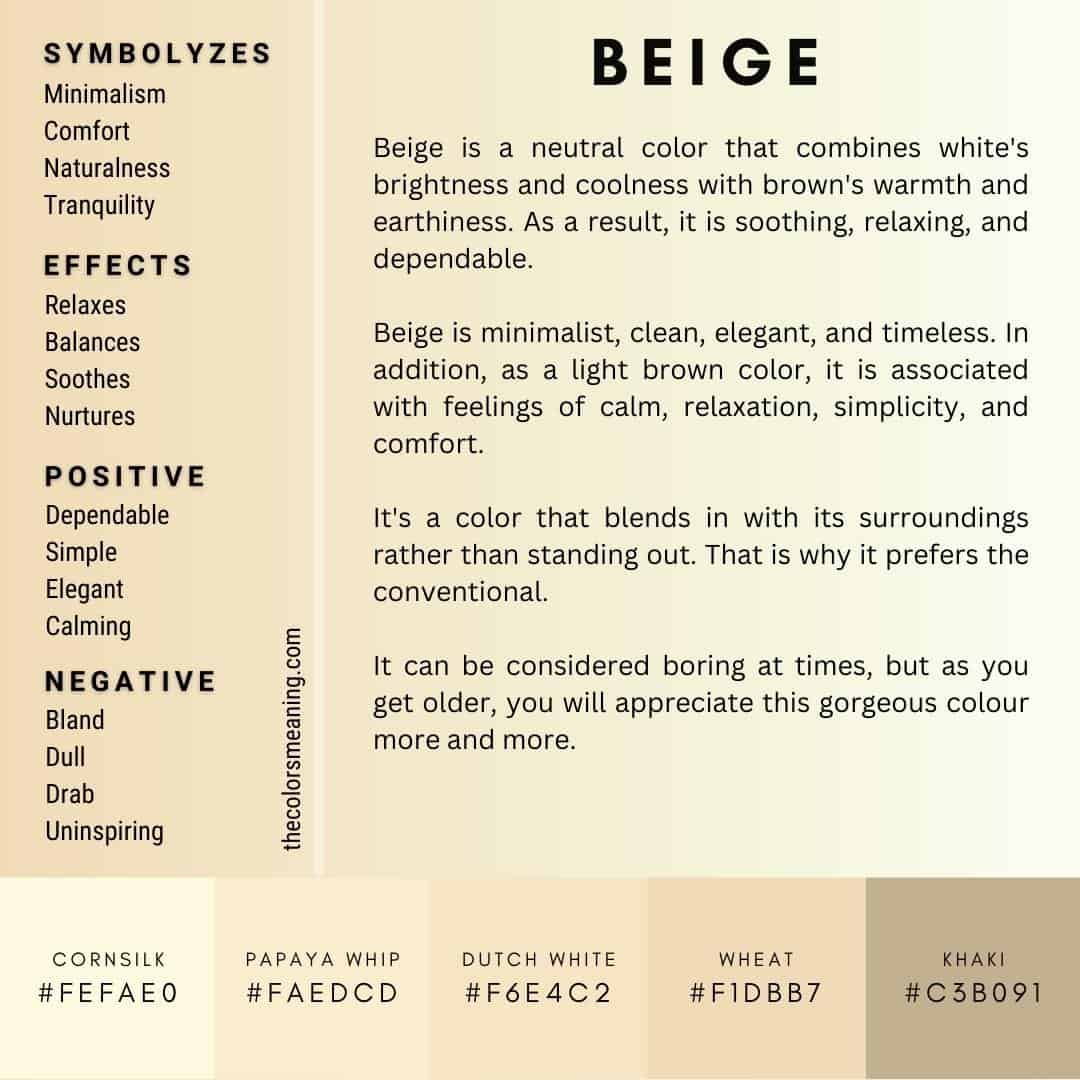Looking for the meaning of the color beige? You’ve arrived at the right place.
Beige is a neutral color that combines the brightness and coolness of white with the warmth and earthiness of brown. As a result, it is calm, relaxing, and dependable. Moreover, as a light brown shade, beige represents simplicity and comfort.
But where can we really find the meaning of beige? Definitely in nature.
Beige, whether found in natural fibers, stone, desert sand, limestone, or clay, has a calming effect that allows you to relax.
It is said to be of Pitevin origin and dates back to the 18th century when it was used to describe the natural state of wool.
In today’s article, we will discuss the symbolism and meaning of the color beige, its common shades, and its uses. Also, to better understand the significance of beige, we need to review the history of this color.
What Color is Beige?
Beige is a light sandy fawn color, similar to grayish yellow, and can refer to a variety of pale brown shades. It gets its name from the French word for natural wool. Its hex code is #F5F5DC.
Beige is a neutral color that ranges from grayish tan and pale sand to light-grayish yellowish brown, light brown, and grayish yellow. Beige is not the same as off-white or cream.
Beige
Hex #F5F5DC
RGB 245, 245, 220
CMYK 0, 0, 10, 4
History of Beige Color
Beige is not a color but rather a group of colors ranging from almost white to light brown, a blend of cream and taupe in a variety of pale shades.
But have you ever wondered about the history of beige? The word “beige” is said to have a Poitou origin and dates back to the 18th century.
In the mid-19th century, beige was adopted by the French to describe the color of natural wool. The French word means “natural wool.”
The connotation of beige changed in the 20th century once the Chanel fashion company opened a beige line, giving rise to an association with elegance and distinction.
Later, Apple designed the Macintosh 128K in a shade of beige. Since then, beige has also become popular in interior design and graphic arts due to its feelings of calm, comfort, and neutrality.
Beige Symbolism in Different Cultures
- The French associate beige with the color of natural wool and other natural, comfortable materials, such as linen, cotton, and even the naturalness of wood. As a result, it is the color of minimalism.
- In Western culture, beige is often associated with conservatism, conformity, and tradition. It is also used for home décor to create a sense of calm and relaxation.
- In some Asian cultures, beige is associated with humility, modesty, and simplicity. It is seen as a reflection of traditional values and cultural heritage.
- In the 1960s, the AT&T telephone company in the United States developed a phone that was the color of sand – a beige shade. The meaning of the color beige was interpreted as something cozy, and homey.
Psychological Meaning of Beige
Beige has a psychological impact on our minds in addition to its cultural significance. Studies have shown that the color beige makes people feel calmer, which makes it a great choice for places where relaxation is important. [1]
Beige is also known for its ability to create a sense of balance and harmony, making it a popular choice in interior design.
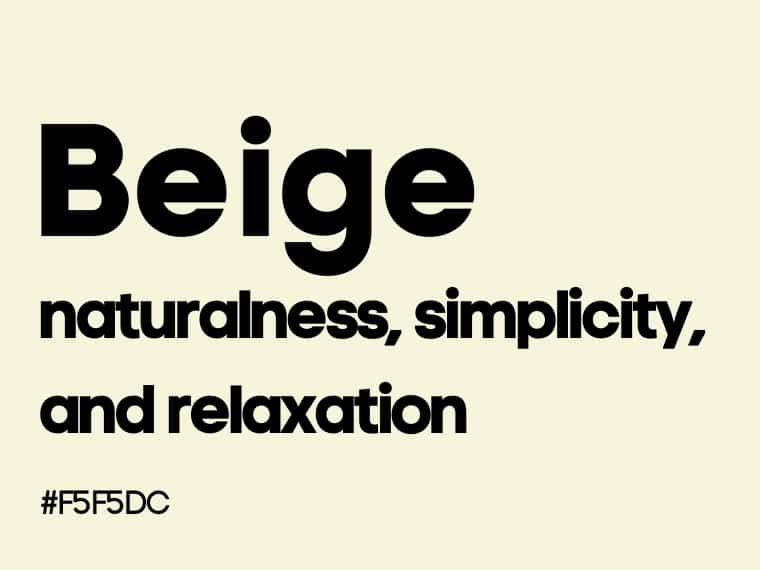
Beige Color Meaning
Beige is minimalist, clean, elegant, and timeless. Moreover, the color beige evokes feelings of calm, relaxation, simplicity, and comfort.
In addition, it is the color of minimalism, far from the cold purity of white and the emptiness of brown.
Here is the meaning of beige from a psychological point of view.
Warmth and Comfort
Because it is a very pale shade of brown, it brings something of the color’s meaning related to warmth, security, and earthiness.
Beige is associated with warmth and comfort. Moreover, it is a color that conveys feelings of calm and relaxation.
Because it promotes inner peace and creates a sense of coziness, it’s a popular choice for bedrooms and living rooms. Especially if you’re prone to nervousness or overthinking.
Stability and Dependability
As part of the brown family, beige finds joy in the safety, stability, and warmth that family and home offer. Because it stabilizes and protects, beige is closely related to home, family, and the earth.
Beige is a color that is often associated with stability and dependability. Moreover, it is a color that can provide a sense of stability and dependability, which can be comforting during times of stress or uncertainty.
Conformity and Neutrality
Beige is a neutral color often associated with conformity and conservatism. It draws from the caution of brown, which doesn’t overstep boundaries, but rather follows the rules. Thus, it is not a color for non-conformists.
It is also an invisible and universal color that goes unnoticed. It does not enjoy being in the spotlight. It is a color “impression” you grow to appreciate as you age.
However, it is the most popular neutral color, and we often see it in traditional settings, such as banks, buildings, law offices, or even bedrooms.
While beige is a safe and non-threatening color, it may also appear monotonous or uninspiring.
Beige is Conventional
Regarding the psychological meaning of beige, its use may also reflect a preference for conventional.
It’s a color that blends in with its surroundings rather than drawing attention to itself.
As a result, it can be perceived as a reflection of conventional thinking, which values adherence to established norms and practices while avoiding drawing attention to itself.
Reliability and Simplicity
Beige brilliantly combines brown’s reliability and dependability with white’s simplicity.
That’s why beige is a practical color often associated with simplicity and minimalism. As a result, it is one of the most popular interior design colors.
Cleanliness
Beige is associated with cleanliness, but psychologists cannot explain why. When you see beige, you expect to see cleanliness. So, yes, beige has this effect. As a result, interior designers frequently end up choosing beige shades.
So, although often seen as a boring color, beige exudes soft elegance, calm, warmth, and relaxation. It has a subtle charm.
Naturalness
Because of the origin of the name, it seems unsurprising that it is associated with nature. In addition, it has a similar hue to many natural materials, such as sand, stone, certain types of wood, various fabrics, and even earth.
Physical Effects of Beige
- Calms down: Beige is a calming color that can help to reduce stress and promote relaxation, making it a popular choice for bedrooms, living rooms, and other spaces where people want to unwind.
- Stimulates: In some cases, beige can stimulate you negatively. So, if you find beige a boring color, it is better to stay away from it because its dullness can make you nervous.
- Promotes impartial thinking: Beige encourages a broad sense of neutrality and impartiality.
Common Uses of the Color Beige
- Interior design: Beige is a popular color for home walls and furniture because it is a fantastic neutral, both calming and relaxing, that complements many other colors and provides a sense of cleanliness. If you want to create a warm and inviting atmosphere, go for beige without hesitation.
- Fashion: Beige clothing items, such as jackets, pants, and shoes, are often worn as neutral staples. Furthermore, it is involved in the production of clothing from natural materials such as linen, wool, or cotton.
- Make-up products: Beige is a popular make-up color, particularly for foundation and powders, because it can blend in with warmer skin tones.
- Packaging: Beige is used for packaging many things, including food, cosmetics, and even technology-related products because it conveys a sense of naturalness, simplicity, and comfort.
- Art: Popular in painting and other kinds of art, beige is used for creating a gentle, relaxing effect or emphasizing the texture of the surface.
- Architecture: Beige-colored materials, such as stones, bricks, or tiles, are frequently used in buildings to produce a classic, timeless effect or to complement other colors.
- Advertising: Beige is frequently used for products intended to be perceived as high-quality and classic.
Shades of Beige
Beige is a timeless color that symbolizes minimalism, simplicity, and naturalness.
The color beige covers a wide spectrum of shades from pale browns and grayish tans to light-grayish yellows.
Here are some of the most beautiful shades of beige.
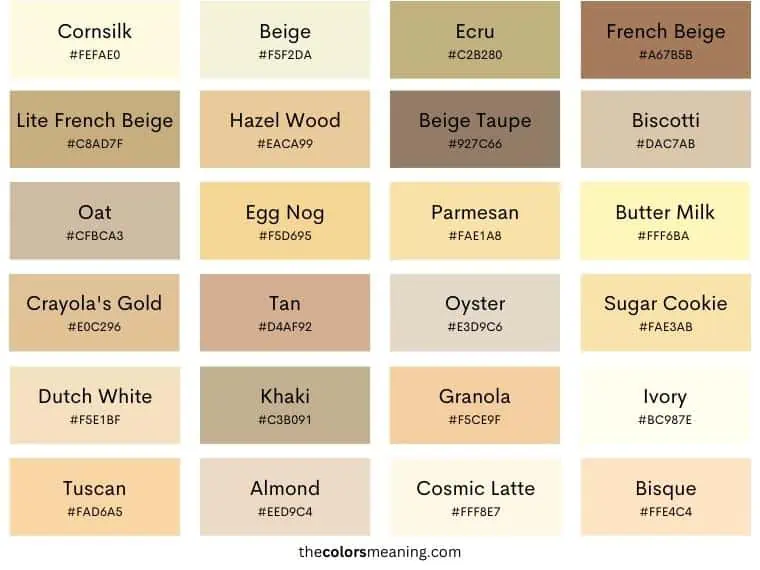
Ivory, tan, macaroon, oat, granola, egg nog, sand, latte, oyster, hazelnut, buttermilk, and sandcastle are can be described as shades of beige.
Ivory: A warm-toned shade of beige, ivory is neutral, soothing, and calming. It has the purity of white but with a warmer tone that evokes pleasantness.
Ivory
Hex: #FFFFF0
French Beige: This is the most popular shade of beige. It’s the color of natural wool, where the term “beige” came from.
Light French Beige
Hex: #C8AD7F
Brown beige: It was the popular interior color in the 1970s. It has recently had a resurgence in popularity, this time in a more muted tone that facilitates the creation of a vintage atmosphere.
Brown Beige
Hex: #AB814F
Cream: Cream is a smooth and warm shade of off-white with a slight tint of beige. You can call it a soft, muted yellow or a pastel yellow. There is a misconception that beige is the same color as cream.
Cream
Hex: #FFFDD0
Khaki: A popular shade of beige, khaki is a light brown with yellow undertones. Because of its excellent camouflage properties, it is widely utilized in numerous armies worldwide.
Khaki
Hex: #C3B091
Buff: Buff is a less popular beige hue that might contain yellow or brown undertones. It gets its name from the natural leather appearance before it is colored.
Buff
Hex: #E5C9AF
Ecru: This is a soft and muted beige with a subtle hint of yellow or gray.
Ecru
Hex: #C2B280
Whether it is called khaki, ecru, French beige, cream, or dessert sand, the meaning of the color beige is related to the calming and relaxing effect it offers.
Beige Color Palettes
Here are some lovely beige color palettes to inspire you, whether you’re painting walls or creating a website.
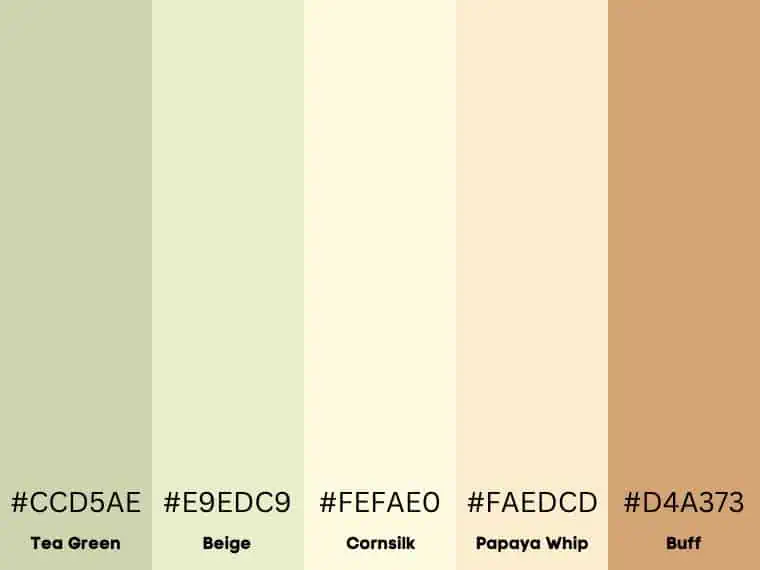
A beige color palette is shown below as a gradient from light to dark shades.
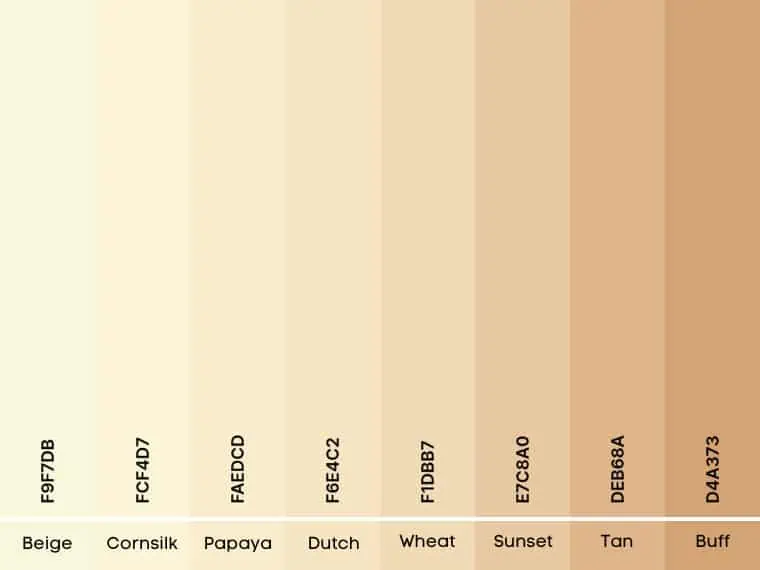
Facts About the Color Beige
- The first Macintosh made by Apple was beige.
- Beige was used in the 19th century by the French to describe the natural color of wool.
- The most popular painting in shades of beige is Leonardo da Vinci’s Mona Lisa, which can be seen in the Louvre Museum in Paris.
What Colors Make Beige?
Beige is produced by mixing yellow and brown paint. To be more specific, two parts yellow and one part brown will yield a light beige.
To make a darker beige, combine three parts yellow and one part brown. Alternatively, for an off-white beige, add two parts white to the mix.
Idioms with the Word Beige
- To live in beige: It means to lead a life that is dull and uninteresting.
- Beige and bland: It can refer to a person or anything considered uninteresting or unimpressive.
- To see the world in beige: To have a limited, narrow-minded perspective.
Summary of What Beige Color Means
Beige is a neutral color often associated with calm, relaxation, and comfort. Moreover, it symbolizes minimalism and simplicity.
Beige symbolizes: comfort, tranquility, comfort, naturalness
Effects of beige: soothes, relaxes, nurtures, balances
Positive traits: dependable, simple, elegant, calming
Negative traits: bland, dull, uninspiring, drab

